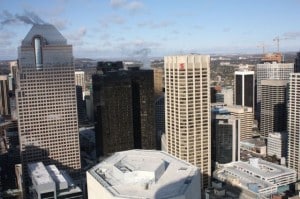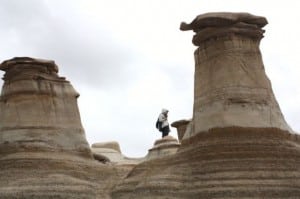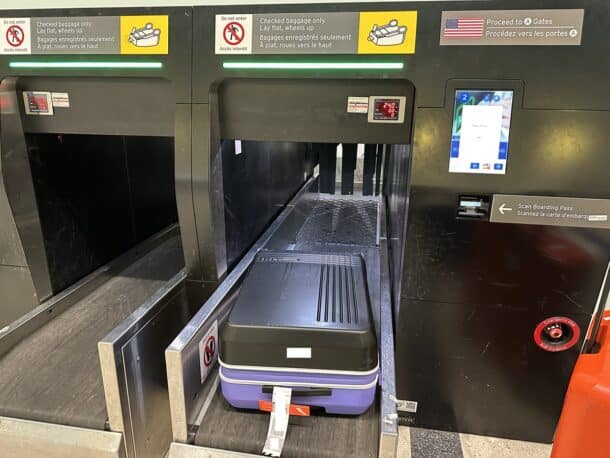
By Dave Zuchowski:
Stroll through downtown Calgary and you’ll see skyscrapers named after big oil and energy companies like Husky, Petro-Canada, and the new EnCana. As oil-rich Houston is to the U.S., Calgary is to Canada, not only in its concentration of energy companies, but also its rugged western image that includes the annual Stampede, probably the world’s greatest rodeo, which attracts over a million visitors each summer.
One thing this bustling Albertan city of more than a million residents has over its Texas counterpart is the Rocky Mountains, which loom on the horizon just to the west. You can catch a glimpse of the Rockies’ snow-capped peaks from the downtown area on a clear day; one of the best places to enjoy the scenic panorama is from the top of the Calgary Tower.
Rising to a height of 626 feet, the tower has a round donut of observation deck at the top of the spire that allows visitors to walk around 360 degrees tosee the city and surroundings from all angles through huge glass walls.
For an even more thrilling experience, one section of the tower juts out from the observation deck and has a glass floor that can be walked on and looked through to the street below. If you’re the least bit vertiginous, beware.
They say that on a windy day the tower can sway 7.5 inches, but don’t let that stop you from dining in the revolving restaurant, aptly called Sky 360. I hear the food is good, and diners get a free ride to the top with the purchase of an entrée. Spend enough time over lunch or dinner, and the restaurant will make an entire 360-degree revolution during your meal.
With its copious influx of oil money, Calgary has become quite a cultural center; the city now has about 40 live theater companies. One of these is located just below Calgary Tower and aptly called the Vertigo Theatre; it specializes in mystery drama.
During my visit, I managed to catch a riveting performance of Blood Relations, a look at the notorious 1909 ax murders of the Borden family in Fall River, Massachusetts, written by Canadian playwright Sharon Pollock. Sharing the inner thoughts of Lizzie Borden and a friend, the play covers the period just before the homicides and continues on to the trial and aftermath, detailing what’s known about the crime and its victims.
Vertigo’s Forensic Friday takes place immediately following the performance on the third Friday of each production; I especially enjoyed the Q and A with members of the cast, artistic director Mark Bellamy, and detective John Watson, a police forensics expert familiar with the case; . Watson and company shed additional light on the murders and even brought along photographs of the crime scene that show the ugly havoc in black and white.
On a more civil note, my exploration of the Eau Claire Market took me to the banks of the Bow River where I discovered a multistory building that houses more than 60 unique stores, restaurants, and a six-screen cineplex. Wandering through the building, I discovered a fine wine shop; Zen and Accessories, a funky emporium selling Oriental-themed merchandise including some exotic floor lamps to die for; and Tibetan Trom, a store that sells prayer wheels, clothing, jewelry, singing bowls, and more, all made by Tibetan refugees living in Nepal.
On my way out I made one last turn and walked into Son of the Pharaoh, a purveyor of Egyptian imports that include incense, statues of ancient Egyptian deities, hand-blown glass eggs and bottles, silver pendants and rings, perfume, CDs of Arabic music, reproductions of artifacts from the Egyptian Museum in Cairo, even a life-size wine caddy in the shape of a sub-Saharan servant.
Calgary’s Bustling Cultural District
Just as Calgary’s oil men have been seen as risk takers when drilling for oil and natural gas, the same trait seems to have rubbed off on the city’s creative community.
“Our artists are big into pushing boundaries,” Dr. Terry Rock, president and CEO of Calgary Arts Development, told me over lunch at the Avenue Diner on 8th Avenue. “We have lots of contemporary theater going on and our visual arts scene encompasses cutting-edge artists from all over Canada and abroad.”
Speaking of theater, each January Calgary stages its annual High Performance Rodeo, a play on the city’s western cowboy image. Starting off with theater-based events, the Rodeo eventually expanded to include all the arts, including literary, visual, and installation art, as well as dance and music.
Each February, Calgary also hosts the Enbridge Playwrights Festival of New Canadian Plays. Although the actors are mostly local, the playwrights selected are from all parts of Canada. The theater festival is set to stage its 100th world premier in 2011—a clear indication of its prodigious output.
“If you’re into the arts, the first two months of the year is the time to be in Calgary,” said Rock. “As an added bonus, you can also go skiing nearby in the Rockies for some of the best snow in the world that time of year.”
Another time for arts lovers to be in Calgary is the first Thursday of each month, when the city’s 14-block Cultural District in the heart of town holds its culture crawl, which can start with breakfast in the morning and continue throughout the day until 2 p.m.
“Patrons can go to the theater and visual art openings, get meal and drink discounts in our restaurants, take a historic walking tour, and enjoy some behind the scene activities,” Rock explained.
Geographically, the Cultural District begins at Olympic Plaza, where the medal ceremonies of the 1988 Winter Olympics took place, and extends along Stephen Avenue, with its string of attractive historic sandstone buildings.
The district encompasses the Epcor Center for Performing Arts—the third largest in Canada with four theaters, including one for the Calgary Philharmonic Orchestra; the Glenbow, one of western Canada’s largest museums; the Art Gallery of Calgary (AGC); and Art Central, a visual art complex that was renovated to accommodate 57 individual spaces for studios, art galleries, and artsy boutiques as well as a restaurant and café.
While in Calgary I breezed briefly through the Glenbow Museum, which has holdings of more than one million objects, and was impressed with its “Mavericks” section, which tells the interesting stories of 48 significant, colorful, and adventurous Albertans.
Another impressive gallery is devoted to the Blackfoot tribes that have inhabited this part of North America for thousands of years, but I also saved time for a look at the museum’s holdings of historical and modernist paintings.
Foodies can also take heart with the Cultural District’s array of dining options. “From a restaurant perspective, the district has everything from the popular Avenue Diner to high-end restaurants with amazing wine lists,” said Rock. “There’s really something here for everyone, whether it be a falafel or a gourmet burger.”
The Canadian Badlands
 I’d heard of the Badlands of North Dakota, and when I discovered that Canada has a Badlands of its own I jumped in my rental car and headed northeast about 70 miles from Calgary for a look around.
I’d heard of the Badlands of North Dakota, and when I discovered that Canada has a Badlands of its own I jumped in my rental car and headed northeast about 70 miles from Calgary for a look around.
My main interest focused in and around the town of Drumheller, in the heart of the Badlands and known for being home to the “world’s largest dinosaur.” Before entering town, I made a quick stop at Horseshoe Canyon, where I got my first taste of Canada’s Badlands.
After traversing miles of flat Albertan prairie, I was amazed to see how dramatically the canyon falls from a high cliff and makes an abrupt change of terrain. The scenery is spectacular: The canyon’s two long arms cut their way through gray rock walls speckled with a variety of multicolored vegetation. A sign at the top of the cliff informs visitors that the canyon formed during the last glacial period 22,000 to 12,000 years ago, although the rocks in the area are estimated to be roughly one to two million years old.
A few miles east, the village of Drumheller sits in Badlands Valley at the foot of a steep decline. It reminds me of a small western town with its familiar string of restaurants, motels, shops, and other tourist enterprises along the main road.
Stop first at 60 First Avenue West to pick up maps and information on the area at the Drumheller Visitor Center. This is also where you can plop down $3 to climb a staircase 86 feet up into the mouth and gaping jaws of a giant fiberglass T. rex. Four times the size of the real deal, the fabricated beast is 151 feet long, weighs in at 145,000 pounds, and gives climbers a great view of the area.
Four miles west of Drumheller, the spectacular Royal Tyrell Museum is home to more dinosaur skeletons than any other attraction in the world. The museum is named after Joseph Burr Tyrrell, a geologist who discovered the first dinosaur fossil in the Red Deer Valley in 1884.
Over 400,000 visitors travel to this large, eye-catching modern building that stands out in contrast to the stark landscape that surrounds it.
Noted for its collection of 120,000 fossils, the museum offers displays and exhibits that trace millions of years of the Earth’s history in galleries arranged in chronological order, starting 200 million years ago with the Terrestrial Paleozoic and ending with the Ice Age and its woolly mammoths and saber-toothed tigers.
One of the most popular galleries, the Dinosaur Gallery, displays nearly 40 dinosaur skeletons, including that of a Tyrannosaurus rex, an Albertosaurus, and the giant Camarasaurus.
The museum even has a gallery devoted to imagining what Alberta looked like during the Devonian Period, when the province was covered by a tropical sea. Thousands of life-like models are assembled in the gallery to re-create the incredible colorful diversity of the ancient underwater world that was once Alberta.
If You’re Going
For more information on Calgary, phone 800-661-1678 or visit TourismCalgary.com.
For a place to stay, the Nuvo Hotel Suites at 827 12th Avenue in Calgary is a modern boutique hostelry within walking distance to the city’s rail line and many of its attractions in the downtown core. The suites have complimentary phone service to anywhere in North America and a fully equipped kitchen for those who might want to save on restaurant expenses. Phone 403-452-6789 or visit NuvoHotelSuites.com.
For a place to dine, Il Sogno (The Dream) at 24 Fourth Street NE features inspired Italian food by talented chef Christopher Picek. Housed in a charming two-story red brick building built in 1910 in Edwardian Commercial Style, Il Sogno won the Wine Spectator Award of Excellence three years running and is one of only three 4 diamond–rated restaurants in the city. To view the menu, visit website IlSogno.org. Phone 403-232-8901.
Bonterra Trattoria (1016 8th St. SW) is housed in an old train barn turned romantic setting, complete with captivating patio out back. In the words of function coordinator, Tim Ormond, Bonterra serves casual, unpretentious style food done top-notch with seasonal flavors.
Try the burrata cheese, which is flown in from Montreal and has a two-day shelf life; one of the chef’s signature dishes, octopus and potatoes; or pasta carbonara with wild boar. The wine list has won the Wine Spectator Award of Excellence every year since 2002 and 90 percent of the selections are Italian. Check out the menu at Bonterra or phone 403-262-8480.
WEB RESOURCES:
Note: This trip was sponsored in part by Tourism Calgary.
ABOUT THE AUTHOR
Dave Zuchowski has been writing about travel for twenty years and his articles have made the pages of many newspapers and magazines across the country, including AAA, Pathfinders, West Virginia Magazine, Southsider, and Westsylvania. Currently, he is the travel correspondent for the New Castle News, a daily in the Pittsburgh area. In his spare time, he also puts his horticultural interests to good use on his 15-acre farm located near Centerville, PA.









